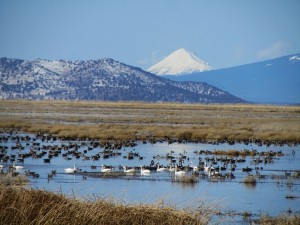
Our Klamath Basin Water Crisis
Upholding rural Americans' rights to grow food,
own property, and caretake our wildlife and natural resources.

Our Klamath Basin
Water Crisis
Upholding rural Americans' rights to grow food,
own property, and caretake our wildlife and natural resources.
|
Pacific Northwest’s Klamath Basin
a Possible Site for Geothermal Energy Plant
by Leigh Kim November 28, 2012, Green Optimistic 11/28/12 
There are currently three high-volume,
low-heat geothermal energy plans in the world. These are
located in Japan, Germany, and Iceland. By the end of
2013, if all goes according to plan, there may be a
fourth plant, located in the Klamath Basin, which spans
parts of California and Oregon.
In mid-November, two potential plant
locations were chosen in the Basin: The Lower Klamath
National Wildlife Refuge and private land owned by
Klamath Basin farmer and president of Entiv Organic
Energy, Mike Noonan. In fact, regardless of the final
choice, Entiv hopes to pursue and foster geothermal
projects in the Basin.
The French company, Technip, originally
created the geothermal technology. Subsurface water was
discovered after wells were dug as a response to the
2001 water shut-off. The discovered subsurface water was
too warm for wetlands and irrigation and too cold for
traditional geothermal energy production. The water’s
temperature seemed to hover between 190 and 250 degrees.
In order to preserve the wetlands, the
Klamath Basin needs moving water, a commodity that has
risen considerably in cost. Moving an acre foot of water
used to cost 33 cents and now the same acre foot of
water costs $9.23 to move. This translates into higher
barriers for refuge water transport. The refuge has the
plumbing and method for transport, all it needs is the
water, but the water is expensive.
If it’s built, the new geothermal plant
will lower water rates for both agriculture and the
wildlife refuge. Noonan has stated that Entiv has paid
all its bills and has not cost taxpayers a dime. Since
the water is sent back underground, there has been no
consumptive use of water. Entiv is optimistic that this
project will yield a 10 megawatt capacity.
==================================================== In accordance with Title 17 U.S.C. section 107, any copyrighted material herein is distributed without profit or payment to those who have expressed a prior interest in receiving this information for non-profit research and educational purposes only. For more information go to: http://www.law.cornell.edu/uscode/17/107.shtml |
Page Updated: Friday November 30, 2012 02:34 AM Pacific
Copyright © klamathbasincrisis.org, 2001 - 2012, All Rights Reserved